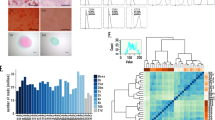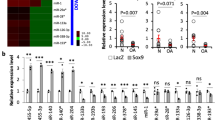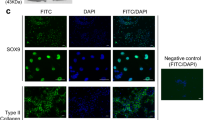Abstract
We have performed a comprehensive analysis of gene-expression profiles in human articular cartilage (hyaline cartilage) and meniscus (fibrocartilage) by means of a cDNA microarray consisting of 23,040 human genes. Comparing the profiles of the two types of cartilage with those of 29 other normal human tissues identified 24 genes that were specifically expressed in both cartilaginous tissues; these genes might be involved in maintaining phenotypes common to cartilage. We also compared the cartilage profiles with gene expression in human mesenchymal stem cells (hMSC), and detected 22 genes that were differentially expressed in cells representing the two cartilaginous lineages, 11 specific to each type, which could serve as markers for predicting the direction of chondrocyte differentiation. Our data should also provide useful information about regeneration of cartilage, especially in support of efforts to identify cartilage-specific molecules as potential agents for therapeutic approaches to joint repair.
Similar content being viewed by others
Log in or create a free account to read this content
Gain free access to this article, as well as selected content from this journal and more on nature.com
or
References
Ballestar E, Wolffe AP (2001) Methyl-CpG-binding proteins: targeting specific gene repression. Eur J Biochem 268:1–6
Bi W, Deng JM, Zhang Z, Behringer RR, de Crombrugghe B (1999) Sox9 is required for cartilage formation. Nat Genet 22:85-89
Burgeson RE, Hebda PA, Morris NP, Hollister DW (1982) Human cartilage collagens: comparison of cartilage collagens with human type V collagen. J Biol Chem 257:7852–7856
Carlberg AL, Pucci B, Rallapalli R, Tuan RS, Hall DJ (2001) Efficient chondrogenic differentiation of mesenchymal cells in micromass culture by retroviral gene transfer of BMP-2. Differentiation 67:128–138
Cha JY, Kim H, Kim KS, Hur MW, Ahn Y (2000) Identification of transacting factors responsible for the tissue-specific expression of human glucose transporter type 2 isoform gene: cooperative role of hepatocyte nuclear factors 1alpha and 3beta. J Biol Chem 275:18358–18365
DeLise AM, Fischer L, Tuan RS (2000) Cellular interactions and signaling in cartilage development. Osteoarthr Cartilage 8:309–334
Ferrari G, Cusella-De Angelis G, Coletta M, Paolucci E, Stornaiuolo A, Cossu G, Mavilio F (1998) Muscle regeneration by bone marrow-derived myogenic progenitors. Science 279:1528–1530
Ikegawa S, Ohashi H, Nishimura G, Kim KC, Sannohe A, Kimizuka M, Fukushima Y, Nagai T, Nakamura Y (1998) Novel and recurrent COMP (cartilage oligomeric matrix protein) mutations in pseudoachondroplasia and multiple epiphyseal dysplasia. Hum Genet 103:633–638
Kitahara O, Furukawa Y, Tanaka T, Kihara C, Ono K, Yanagawa R, Nita ME, Takagi T, Nakamura Y, Tsunoda T (2001) Alterations of gene expression during colorectal carcinogenesis revealed by cDNA microarrays after laser-capture microdissection of tumor tissues and normal epithelia. Cancer Res 61:3544–3549
Komori T, Yagi H, Nomura S, Yamaguchi A, Sasaki K, Deguchi K, Shimizu Y, Lefebvre V, Huang W, Harley VR, Goodfellow PN, de Crombrugghe B (1997) SOX9 is a potent activator of the chondrocyte-specific enhancer of the pro alpha1(II) collagen gene. Mol Cell Biol 17:2336–2346
Luscher B, Larsson LG (1999) The basic region/helix–loop–helix/leucine zipper domain of Myc proto-oncoproteins: function and regulation. Oncogene 18:2955–2966
Newton G, Weremowicz S, Morton CC, Copeland NG, Gilbert DJ, Jenkins NA, Lawler J (1994) Characterization of human and mouse cartilage oligomeric matrix protein. Genomics 24:435–439
Ochi K, Mori T, Toyama Y, Nakamura Y, Arakawa H (2002) Identification of semaphorin 3B as a direct target of p53. Neoplasia 4:82–87
Ochi K, Chen G, Ushida T, Gojo S, Segawa K, Tai H, Ueno K, Ohkawa H, Mori T, Yamaguchi A, Toyama Y, Hata J, Umezawa A (2003) Use of isolated mature osteoblasts in abundance acts as desired-shaped bone regeneration in combination with a modified poly-dl-lactic-co-glycolic acid (PLGA)–collagen sponge. J Cell Physiol 194:45–53
Ono K, Tanaka T, Tsunoda T, Kitahara O, Kihara C, Okamoto A, Ochiai K, Takagi T, Nakamura Y (2000) Identification by cDNA microarray of genes involved in ovarian carcinogenesis. Cancer Res 60:5007–5011
Pittenger MF, Mackay AM, Beck SC, Jaiswal RK, Douglas R, Mosca JD, Moorman MA, Simonetti DW, Craig S, Marshak DR (1999) Multilineage potential of adult human mesenchymal stem cells. Science 284:143–147
Rosen ED, Spiegelman BM (2000) Molecular regulation of adipogenesis. Annu Rev Cell Dev Biol 16:145–171
Ross M, Romrell L, Kaye G (1995) Histology: a text and atlas, 3rd edn. Williams & Wilkins, Baltimore
Rudnicki JA, Brown AM (1997) Inhibition of chondrogenesis by Wnt gene expression in vivo and in vitro. Dev Biol 185:104–118
Saito-Hisaminato A, Katagiri T, Kakiuchi S, Nakamura T, Tsunoda T, Nakamura Y (2002) Genome-wide profiling of gene expression in 29 normal human tissues with a cDNA microarray. DNA Res 9:35–45
Spain BH, Bowdish KS, Pacal AR, Staub SF, Koo D, Chang CY, Xie W, Colicelli J (1996) Two human cDNAs, including a homolog of Arabidopsis FUS6 (COP11), suppress G-protein- and mitogen-activated protein kinase-mediated signal transduction in yeast and mammalian cells. Mol Cell Biol 16:6698–6706
Stieber A, Mourelatos Z, Chen YJ, Le Douarin N, Gonatas NK (1995) MG160, a membrane protein of the Golgi apparatus which is homologous to a fibroblast growth factor receptor and to a ligand for E-selectin, is found only in the Golgi apparatus and appears early in chicken embryo development. Exp Cell Res 219:562–570
Takeda S, Bonnamy JP, Owen MJ, Ducy P, Karsenty G (2001) Continuous expression of Cbfa1 in nonhypertrophic chondrocytes uncovers its ability to induce hypertrophic chondrocyte differentiation and partially rescues Cbfa1-deficient mice. Genes Dev 15:467–481
Thur J, Rosenberg K, Nitsche DP, Pihlajamaa T, Ala-Kokko L, Heinegard D, Paulsson M, Maurer P (2001) Mutations in cartilage oligomeric matrix protein causing pseudoachondroplasia and multiple epiphyseal dysplasia affect binding of calcium and collagen I, II, and IX. J Biol Chem 276:6083–6092
Tufan AC, Daumer KM, Tuan RS (2002) Frizzled-7 and limb mesenchymal chondrogenesis: effect of misexpression and involvement of N-cadherin. Dev Dyn 223:241–253
Wade PA (2001) Transcriptional control at regulatory checkpoints by histone deacetylases: molecular connections between cancer and chromatin. Hum Mol Genet 10:693–698
Acknowledgements
We thank Hiroko Bando, Noriko Sudo, Kie Naito, Saori Osawa, Keiko Shigeta, Mika Sanjo, Emiko Takahashi, and Miwako Ando for fabrication of the cDNA microarray; Emi Ichihashi for analysis of the data; Drs Junya Toguchida, Takashi Toyoda, and Hideki Imabayashi for helpful discussions; and Drs Toshiro Otani, Yasuo Suda, Takashi Toyoda, Masanori Imabayashi, and Taku Yatabe for preparing clinical samples. This work was supported in part by Research for the Future Program Grant No. 00L01402 from the Japan Society for the Promotion of Science.
Author information
Authors and Affiliations
Corresponding author
Rights and permissions
About this article
Cite this article
Ochi, K., Daigo, Y., Katagiri, T. et al. Expression profiles of two types of human knee-joint cartilage. J Hum Genet 48, 177–182 (2003). https://doi.org/10.1007/s10038-003-0004-8
Received:
Accepted:
Published:
Issue date:
DOI: https://doi.org/10.1007/s10038-003-0004-8
Keywords
This article is cited by
-
Meniscus, articular cartilage and nucleus pulposus: a comparative review of cartilage-like tissues in anatomy, development and function
Cell and Tissue Research (2017)
-
Meniscus repair using mesenchymal stem cells – a comprehensive review
Stem Cell Research & Therapy (2015)
-
The Knee Meniscus: A Complex Tissue of Diverse Cells
Cellular and Molecular Bioengineering (2009)
-
From cancer genomics to thoracic oncology: discovery of new biomarkers and therapeutic targets for lung and esophageal carcinoma
General Thoracic and Cardiovascular Surgery (2008)



